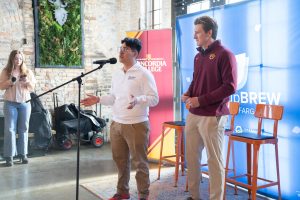After 33 years at Concordia, math professor Dr. William Tomhave will retire at the end of this academic year. What will draw him away are the usual suspects: travel and seeing his grandchildren. What he will miss most from Concordia, however, is the enthusiasm of students.
“The interactions in a classroom are energizing. You feed off them,” Tomhave said.
Part of the excitement of being in the classroom is ignited when his students are working towards becoming teachers themselves. His favorite class to teach has been Math 102, the math class for elementary education majors.
“It allows me to take basic, elementary ideas and approach them from an adult perspective,” Tomhave said.
Students like Adam Presler, senior math education major, have enjoyed Tomhave’s approach to teaching.
“He is always challenging students to think differently and stretch themselves,” Presler said.
Beyond this element of inspiration for students is a bit of fun; Tomhave is known to employ various teaching techniques, including “Math Songs.” These are part witty lyrics, part math comedy, rolled into upbeat songs from artists like Tom Lehrer. Presler explains that this perfectly describes the way that Tomave runs a classroom.
“Keeping a focus on what’s important but having that element of fun,” Presler said.
Incorporating silly internet songs into class time is not the only way things have changed in the math department since Tomhave began teaching at Concordia.
“When I started at Concordia in 1985, the whole department had one personal computer for all the professors and we stored all our data on floppy disks,” Tomhave said.
With the influx of new technology like personal computers and calculators, Tomhave said, both faculty and students have gained a better idea of the mathematical concepts being explained. When Tomhave first started teaching, students had to trust that Tomhave was drawing the graph correctly or that his concepts made mathematical sense. Current technology allows students to see the graphs for themselves and work on the problems first hand, allowing the finer details to be seen in real time.
Tomhave describes the overall changes to campus and students over the past 33 years as “chaotic change.” New resources, both technical and information-based, have made it easier for students to attempt to learn outside the classroom. From high-tech calculators and apps to Youtube videos dealing with mathematical concepts, students have the ability to learn beyond what their professors tell them.
Even though students have all this information and technology at their fingertips, Tomhave worries that some students might not be getting the full knowledge they would have in earlier years.
“There is no shortcut for intellectual learning and [students] have a tendency to want to cut to the chase,” Tomhave said.
Tomhave’s effective balance of teaching and fun, technology and hands-on experience, has led to many of his students to have prosperous careers, beyond the promising futures he ignites.
Reid Froiland, a 2001 Concordia graduate, currently teaches mathematics at Lincoln High School in Thief River Falls, Minnesota, and cited Tomhave as a major influence on how he approaches teaching.
“[Tomhave] epitomizes what relationship-building teaching should be” said Froiland.
Froiland also recalled how Tomhave worked to always give students the care and attention they needed.
“Encouragement when you needed it, but also admonishment when you needed it,” Froiland said.
Beyond teaching classroom decorum, Tomhave taught Froiland that students learn better and can be more engaged when they feel the one doing the teaching is human too. Tomhave expressed this through the “Hangman Method,” which was a way for students to be let out early: if Tomhave made too many mistakes and his students caught them, they could potentially fill up the “hangman” and the class would end.
“We were about 15 minutes into class when someone caught that step two of the proof was wrong. This caused all the succeeding steps to be wrong, and we filled “hangman” right then and there and were done with class,” Froiland said. “I use this in my math classes today … my students know that if we do fill it, we will stop what we are doing and the rest of the period will be time for homework, etc. This keeps them engaged and keeps me on my toes.!”
Tomhave’s absence will be noticed by many current and former students, but his legacy of teaching with enthusiasm and for engagement will remain.
“[Tomhave] brings a sense of joy without sacrificing, rather keeping math at the center,” Presler said.




Be First to Comment